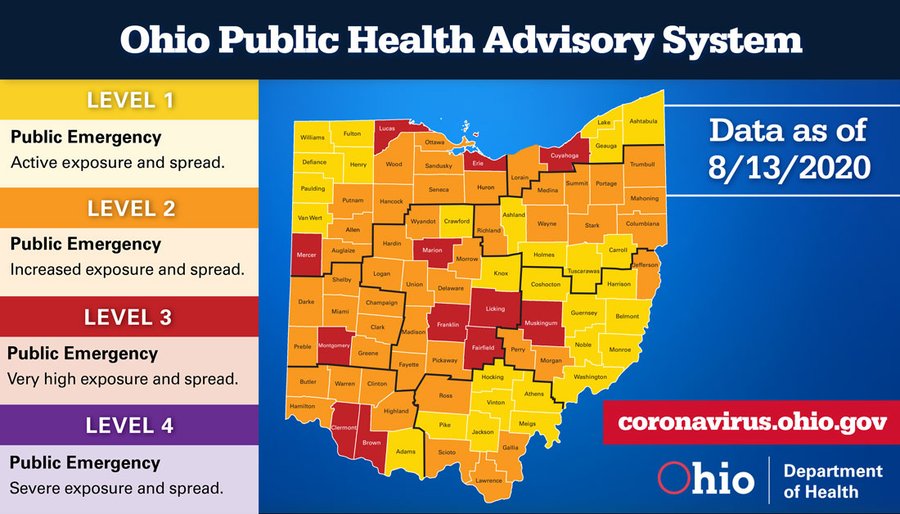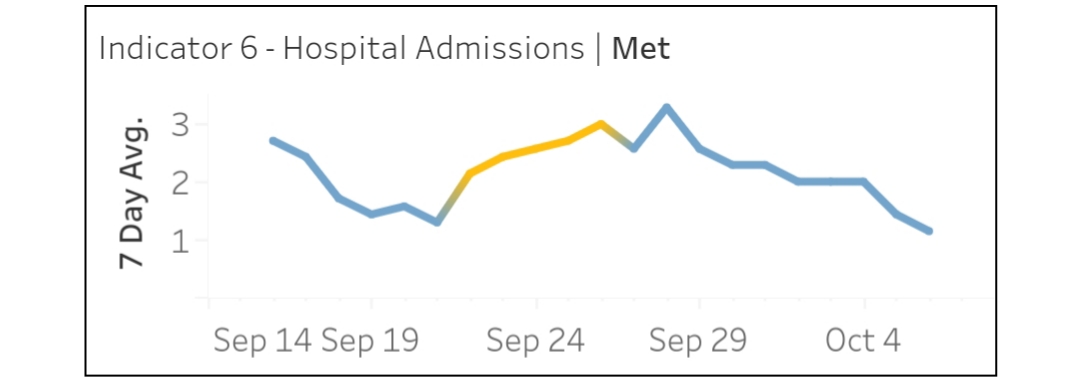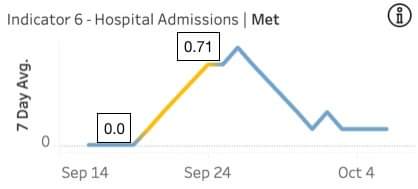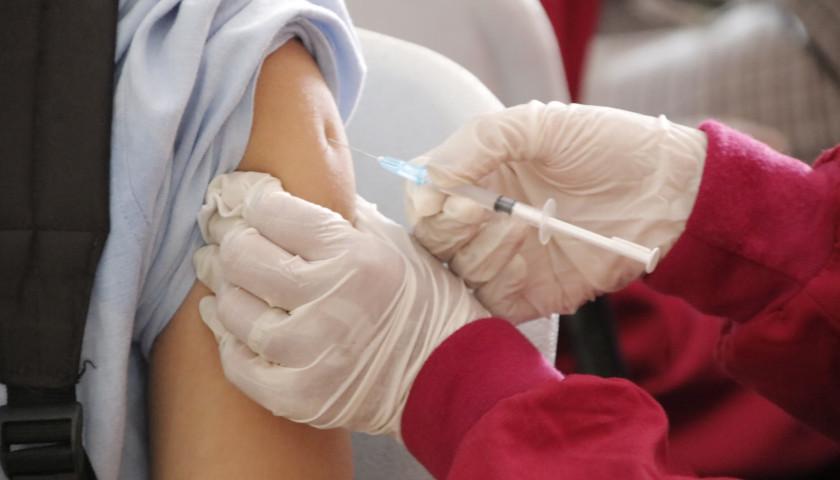This is the seventh story in an eight-part series on the Ohio Public Health Advisory System (OPHAS).
OPHAS is a tool created to supplement the state’s reporting on cases, hospitalizations and deaths.
 The color-coded map assigns each of Ohio’s 88 counties a color determined by how many of the seven indicators comprising OPHAS are triggered by each county. The colors: yellow (0-1 indicator), orange (2-3 indicators), red (4-5 indicators) and purple (6-7 indicators).
The color-coded map assigns each of Ohio’s 88 counties a color determined by how many of the seven indicators comprising OPHAS are triggered by each county. The colors: yellow (0-1 indicator), orange (2-3 indicators), red (4-5 indicators) and purple (6-7 indicators).
The seven indicators making up OPHAS are: 1)-new cases per capita, 2)-sustained increase in new cases, 3)-proportion of cases not in a congregate setting, 4)-sustained increase in emergency department (ED) visits for COVID-like illness, 5)-sustained increase in outpatient visits for COVID-like illness, 6)-sustained increase in new COVID hospital admissions, 7)-intensive care unit (ICU) bed occupancy.
Indicator 6, sustained increase in new COVID hospitalizations, is flagged if there is an increasing trend of at least 5 consecutive days in the number of new hospitalizations due to COVID over the last 3 weeks.
According to the Ohio COVID website, indicator six is an “important indicator of hospital burden and disease severity.”
However, the measure does not give respect to the population size of the county, it simply flags a county negatively if there is a five-day increase.
From September 21 – September 26 Hamilton County tripped the breaker by logging an increase in hospitalizations from 2.14 to 3.0 – in a county with a population of 817,473.

Although touting only a quarter of the population at 209,177 Delaware County provides additional proof of how easy the advisory indicator is triggered – going from .14 on September 20, to .71 on September 24 to activate indicator six.

Delaware County opens another can of worms– statistical sequencing. When numbers are reported is as important as the numbers themselves. This is especially true for indicators that measure “increases over five consecutive days.”
Delaware was resting at zero COVID hospitalizations September 19 but climbed in hospitalizations, as follows:
- September 20: 0.14
- September 21: 0.29
- September 22: 0.43
- September 23: 0.57
- September 24: 0.71
In order for the above numbers to occur over a 7-day average, the Ohio Department of Health (ODH) had to report for Delaware one COVID hospitalization per day over the five-day interval during which the measure was flagged.
Otherwise, the indicator wouldn’t have been flagged. For example, if one day resulted in zero hospitalizations and the subsequent day two, the indicator wouldn’t have triggered because it would not have produced five-day consecutive rise.
Whether the sequencing is correct is uncertain because of conflicting information.
Ohio publishes a comma separated value (.csv) file on the state COVID dashboard. That file is fed by the Ohio Disease Reporting System (ODRS). The ODRS is the database to which hospitals traditionally report directly, but because of the magnitude of COVID reporting, ODH receives information from hospitals and local health departments and in turn enters the data into ODRS.
The ODRS data shows Delaware County had COVID hospital admissions on September 20, September 21 and September 24 – not five consecutive days. The .csv file also shows four additional hospitalizations with unknown onset dates.
It appears, according to the .csv file, that a few of those hospitalizations without onset dates were entered into the system to establish the five-day sequence – perhaps inadvertently.
Nonetheless, the incident raised another question regarding the number of hospitalizations without onset dates – how they are produced and how they get assigned.
The Ohio Star followed-up with ODH Press Secretary Melanie Amato over email and learned that over 9% of Ohio’s hospitalizations (nearly 1,600) have unknown admission dates.
Amato wrote:
The Ohio Department of Health gets this information from the local health departments and hospitals. There are 2 fields in ODRS related to hospitalizations. One just identifies whether the person was hospitalized and the other captures the date of admission. For a case to have an unknown date, it means that the record in ODRS doesn’t have a date associated with the hospitalization.
Sometimes the date comes in later but there are other times when the date is never reported to ODH so it will remain as unknown. We do not make changes to the data we receive therefore we must rely on the local health department or provider entering the data to update these records. Approximately 9.4% of the hospitalized cases have unknown admission dates since the start of the pandemic.
It remains unclear hospitalizations without admission dates are reported in OPHAS and whether there is a constant standard.
An additional issue surrounds the state’s reporting of hospitalizations – both on the state dashboard and OPHAS.
In a previous interview with The Star, Dan Tierney, press secretary for Governor Mike DeWine, addressed how Ohio reports deaths and hospitalizations.
Ohio follows CDC guidelines, Tierney said. What that means is deaths from COVID and deaths form other causes with COVID in the decedent’s system both count as COVID deaths. Likewise, hospitalizations due to COVID and hospitalizations for other reasons but COVID is found in the patient’s system are both counted as COVID hospitalizations.
The situation is ripe for pulling down federal CARES Act money, insurance funds and Medicare 20% bonus outlays (which may now require a positive test), according to CDC Director Robert Redfield.
Redfield addressed the issue when addressed by national leaders on July 31. “I do think though when it comes to hospital reimbursement issues with individuals who get discharged – there could be some play in there for sure.”
– – –
Jack Windsor is Managing Editor and an Investigative Reporter at The Ohio Star. Windsor is also an Investigative Reporter at WMFD-TV. Follow Jack on Twitter. Email tips to [email protected].





